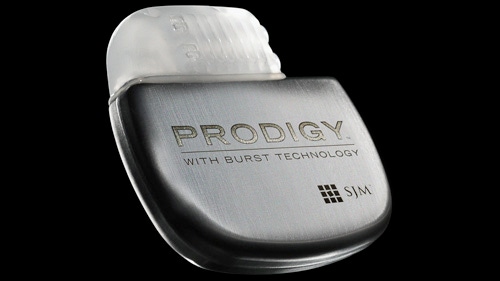St. Jude's Chronic Pain Neurostimulator Aims to Reduce Side-Effect of Tonic Stimulation
A chronic back pain neurostimulation device from St. Jude Medical hopes to reduce or eliminate the side effect of tonic stimulation that creates a tingling sensation for patients.
December 3, 2013

St. Jude Medical's Prodigy Neurostimulator Uses Burst Stimulation to Treat Chronic Pain |
Neurostimulation continues to be an area that companies are exploring to deliver improved therapy for a variety of conditions.
On Tuesday, St. Jude Medical announced that launch of a new U.S. study to evaluate its Prodigy neurostimulator able to provide what is known as burst stimulation to counter chronic pain. Neurostimulation involved the implantation of a device by which mild electrical pulses are provided to the spinal cord to interrupt pain signals from the brain.
Burst stimulation is different from traditional or tonic stimulation in that the implantable device delivers closely spaced, high frequency stimulation to the spinal cord and doesn’t result in the tingling sensation that patients feel during the traditional spinal cord stimulation process. According to a recent study using burst stimulation to treat limb and back pain in New Zealand, because tonic electrical stimulation generates that tingling sensation over the painful area being stimulated, it has never been considered “scientifically superior to placebo” treatment.
The tingling sensation is known as paresthesia.
“Severe chronic pain has a debilitating effect on patients’ lives,” said Dr. Timothy Deer, an interventional pain physician, and president and chief executive officer of the Center for Pain Relief in Charleston, W. Va., a center studying St. Jude’s device, in a news release. “Burst stimulation may provide us with a comprehensive approach to managing patients whose pain is not adequately controlled with tonic spinal cord stimulation alone, or for those who lose therapeutic benefit over time. Importantly, we hope to demonstrate that burst stimulation produces paresthesia-free pain relief which may make it ideal for those who can’t tolerate traditional stimulation.”
Through the study - Sunburst - St. Jude will enroll up to 442 patients in 50 U.S. medical centers. Currently, the product doesn’t have regulatory approval any where in the world, confirmed a St. Jude spokeswoman.
“The Prodigy spinal cord stimulation system with burst stimulation technology represents an important advancement in neurostimulation therapy,” said Dr. Mark D. Carlson, chief medical officer and vice president of global clinical affairs for St. Jude Medical. “We are excited to be leading the effort through the SUNBURST study to bring this novel stimulation mode to market, offering physicians a new alternative to manage patients suffering from severe chronic pain.”
The device, able to provide both burst stimulation and tonic stimuation has a 10-year battery life and requires to be recharged once a week.
-- By Arundhati Parmar, Senior Editor, MD+DI
[email protected]
You May Also Like


